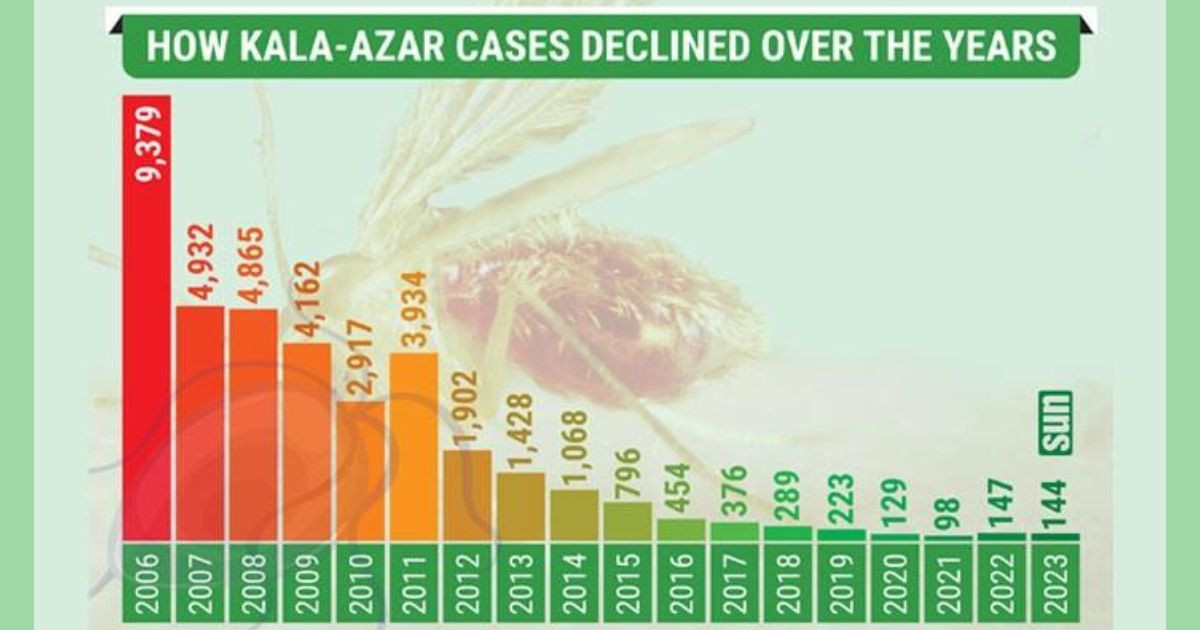
After achieving the goal of eliminating kala-azar, the government now aims to keep the number of cases of the disease at zero in the country.
“Maintaining the elimination status is now a challenge for us. We will carry out our activities to bring down the kala-azar cases to zero in the country,” Dr Sheikh Daud Adnan, director, Disease Control & Line Director, Communicable Disease Control at Directorate General of Health Services (DGHS) told the Daily Sun.
On 31 October 2023, the World Health Organisation (WHO) announced elimination of visceral leishmaniasis or kala-azar (black fever), a life-threatening neglected tropical disease as a public health problem by Bangladesh.
“Bangladesh has become the first country globally to be validated for elimination of visceral leishmaniasis or kala-azar. The country achieved the elimination target of less than one case per 10,000 population at the sub-district (upazila) level in 2017 and has sustained it to date despite disruptions caused by the COVID-19 pandemic,” it said.
According to DGHS, the number of kala-azar cases has been decreasing by day after 2011 (3,934 cases were reported) as the highest number of cases – 9,379 – were reported in 2006 and second highest number of cases – 8,846 – were reported in 1997 in the country.
The DGHS data said only 47 new kala-azar cases were reported in 2022 and 34 in 2023.
Talking to Daily Sun, Dr MM Aktaruzzaman Sohel, programme manager, Filariasis Elimination, STH, LD and National kala-azar Elimination at CDC of the DGHS, said from 2008 to 2011, a total of 100 upazilas in 26 districts were designated as areas where kala-azar was endemic.
He said the country started reducing the kala-azar cases in the 2000s with the support from the World Health Organisation-endorsed integrated vector management strategy. “The sand fly or vector of the kala-azar was controlled through massive drives with insecticide in the endemic areas,” he added.
The Bangladesh National kala-azar Elimination Programme published their national strategic plan in 2006 while the number of visceral leishmaniasis cases in the country had declined by over 95% in the 2007-2021 period.
Sheikh Daud Adnan said they have already taken various measures to maintain the elimination stage of the kala-azar situation and to keep it at non-transmission level.
“The government is working to strengthen case diagnosis, treatment, surveillance and vector control in the post validation phase and achieve zero new kala-azar by 2030,” he said.
The health official further said they have set up a Centre of Excellence for kala-azar at Infectious Diseases Hospital in Mohakhali of the capital as referral treatment centre for the infectious disease. The centre will be inaugurated on Thursday at a function.
MM Aktaruzzaman Sohel said the DGHS has started works to establish and strengthen a reference laboratory system for more sensitive and specific diagnosis of different kala-azar cases.
“At the same time, we will carry on surveillance against the disease regularly to ensure treatment and to deal with any reappearance of symptoms and signs of kala-azar,” he added.
Kala-azar is a notifiable disease in Bangladesh under the Infectious Diseases Prevention, Control and Elimination Act 2018.
Talking to the Daily Sun Prof Dr Be-Nazir Ahmed, a public health expert said the kala-azar disease may reemerge after years like many other diseases. “So, vector surveillance and patient surveillance will have to be continued for quite some time,” he said.
The WHO said kala-azar, the most severe form of leishmaniasis, is a life-threatening disease caused by Leishmania spp. parasites transmitted by infected female phlebotomine sandflies.
It affects the most disadvantaged rural communities, among whom poverty, poor housing conditions, malnutrition, genetic factors and other infectious diseases are major risk factors. kala-azar leads to symptoms such as fever, weight loss, spleen and liver enlargement, and, if left untreated, can prove fatal in over 95% of cases.

